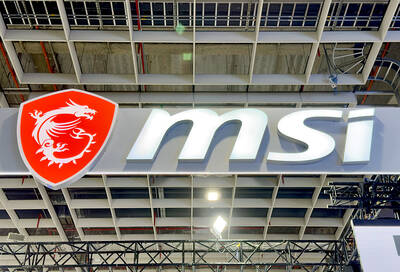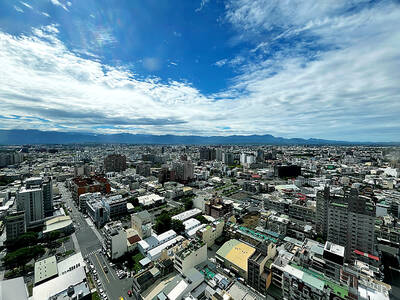Gap Inc plans to open three stores in Taiwan this year as the iconic US clothes retailer seeks to boost revenue by expanding to rapidly growing Asian markets, a company executive said yesterday.
The expansion is part of Gap’s plan to open 30 new stores across the Greater China region this year, which would give it more than 100 stores in the region by the end of this fiscal year.
The 45-year-old Gap is scheduled to launch its first store in Taipei tomorrow, two years after Spanish fashion brand Zara entered the Taiwanese market. The 1,500m2 flagship store is located within the ATT4FUN shopping mall in Xinyi District (信義).
The company plans to open a second store in the capital later this month and a third in central or southern Taiwan later this year, the company said.
The company will introduce its Gap-branded products to Taiwan. It does not plan to introduce other brands, such as Old Navy or Banana Republic.
Gap president for the Greater China region Jeff Kirwan said the company had seen strong growth in the US with the acquisition of new brands such as Intermix and Athleta, but it would seek larger growth by expanding around the world.
“We see Taiwan as an important milestone in our regional expansion and a market with ample opportunity for growth,” Kirwan said.
Asia is one of the largest growth engines for the US brand, contributing US$1.4 billion, or nearly 9 percent, to the company’s total revenue during last fiscal year, which ended on Feb. 1.
Asked about competition with other brands, such as Zara and Japan’s Uniqlo, Kirwan said Gap is strong in baby and children’s clothing, which accounts for more than 20 percent of the company’s overall revenue.
Uniqlo operates 43 stores in Taiwan, while Zara has six.
In addition to brick-and-mortar stores, Gap also plans to launch an e-commerce service allowing consumers to shop online, Kirwan said.
Sales via e-commerce grew 21 percent annually in the final quarter of last year.
In the last fiscal year, Gap’s total revenue grew 3 percent to US$16.15 billion from US$15.65 billion the previous year, according to the company’s financial statement.
Revenue from Asia grew at 6.64 percent annually during the same period.

Meta Platforms Inc offered US$100 million bonuses to OpenAI employees in an unsuccessful bid to poach the ChatGPT maker’s talent and strengthen its own generative artificial intelligence (AI) teams, OpenAI CEO Sam Altman has said. Facebook’s parent company — a competitor of OpenAI — also offered “giant” annual salaries exceeding US$100 million to OpenAI staffers, Altman said in an interview on the Uncapped with Jack Altman podcast released on Tuesday. “It is crazy,” Sam Altman told his brother Jack in the interview. “I’m really happy that at least so far none of our best people have decided to take them

BYPASSING CHINA TARIFFS: In the first five months of this year, Foxconn sent US$4.4bn of iPhones to the US from India, compared with US$3.7bn in the whole of last year Nearly all the iPhones exported by Foxconn Technology Group (富士康科技集團) from India went to the US between March and last month, customs data showed, far above last year’s average of 50 percent and a clear sign of Apple Inc’s efforts to bypass high US tariffs imposed on China. The numbers, being reported by Reuters for the first time, show that Apple has realigned its India exports to almost exclusively serve the US market, when previously the devices were more widely distributed to nations including the Netherlands and the Czech Republic. During March to last month, Foxconn, known as Hon Hai Precision Industry

PLANS: MSI is also planning to upgrade its service center in the Netherlands Micro-Star International Co (MSI, 微星) yesterday said it plans to set up a server assembly line at its Poland service center this year at the earliest. The computer and peripherals manufacturer expects that the new server assembly line would shorten transportation times in shipments to European countries, a company spokesperson told the Taipei Times by telephone. MSI manufactures motherboards, graphics cards, notebook computers, servers, optical storage devices and communication devices. The company operates plants in Taiwan and China, and runs a global network of service centers. The company is also considering upgrading its service center in the Netherlands into a

Taiwan’s property market is entering a freeze, with mortgage activity across the nation’s six largest cities plummeting in the first quarter, H&B Realty Co (住商不動產) said yesterday, citing mounting pressure on housing demand amid tighter lending rules and regulatory curbs. Mortgage applications in Taipei, New Taipei City, Taoyuan, Taichung, Tainan and Kaohsiung totaled 28,078 from January to March, a sharp 36.3 percent decline from 44,082 in the same period last year, the nation’s largest real-estate brokerage by franchise said, citing data from the Joint Credit Information Center (JCIC, 聯徵中心). “The simultaneous decline across all six cities reflects just how drastically the market